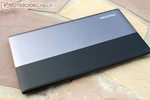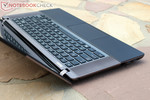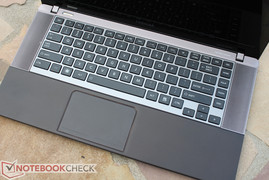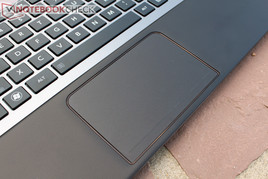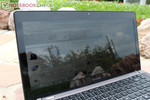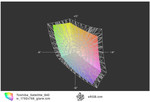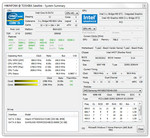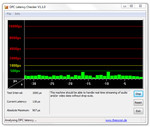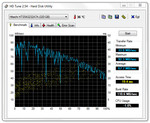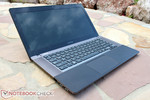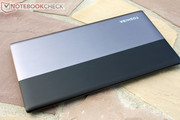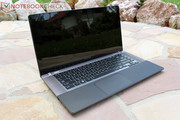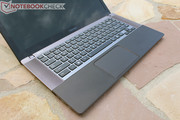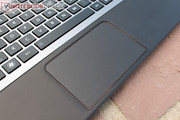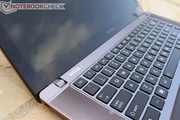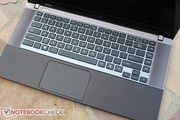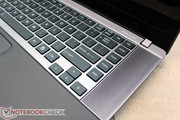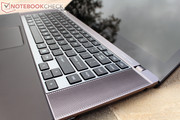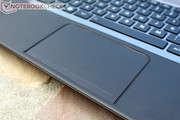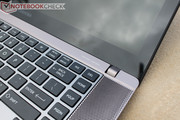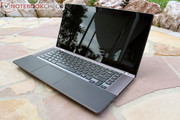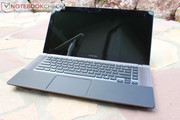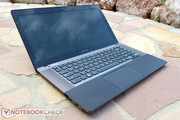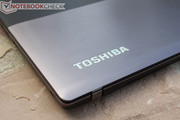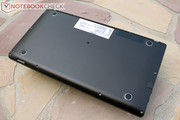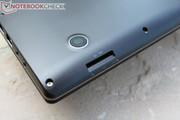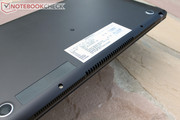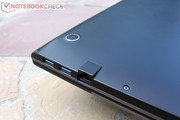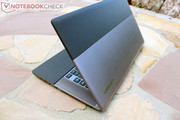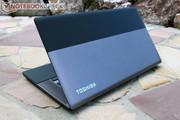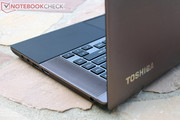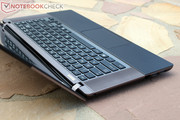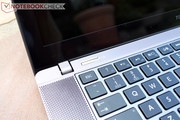Review Toshiba Satellite U840W 21:9 Ultrabook

Trends come and go - some prevail, most are forgotten almost immediately. Display aspect ratios have changed over the years, first from 4:3 to the more widescreen 16:10; later some manufacturers adopted the change to the even wider 16:9. That doesn't mean that the "old" aspect ratios are gone for good, since some manufacturers decided to stick with 16:10. Apple still uses the downright antiquated 4:3 ratio for the iPad - and with great success if the sales numbers are of any indication.
To distinguish itself from the rest of the pack and to offer potential customers a differentiating feature, Toshiba will be gearing up to launch an Ultrabook with a 21:9 aspect ratio. Movie fans are the obvious target, but Toshiba also expects advantages for the office-type user due to the additional 426 pixels of display width.
In addition to the Satellite U840W, a "regular" version (called the U840 and featuring a standard 14-inch display) will also be offered. In the following test, we are going to take a look at a pre-production unit of the Satellite U840 Ultrabook. Here, we specifically focus on the rather unconventional display.
Since this is a pre-production sample, please keep in mind that not all specs or even the hardware have been finalized. Toshiba has cautioned us that the press images used for the U840W are not final, either.
Case
We immediately noticed the different footprint during the unpacking process. It takes some getting used to - but we became comfortable with the new notebook after a few minutes of use. The Toshiba designers incorporated the widescreen theme into the appearance. As a result, the display lid has two separate sections: one part is aluminum, the other has a rubberized and textured coating. This visual separation continues on the inside: the keyboard has a frame in steel grey while the palmrest is black and textured.
As far as appearance and feel are concerned, our test sample makes a convincing statement. The U840W oozes high-end and feels like it belongs in the upper echelon of Ultrabooks. Build quality is already impressive considering its pre-production state.
The very wide display can easily be opened with one hand; the hinges allow the screen to be tilted back a maximum of 140° degrees. Although the display on our sample would rock a bit back and forth, the motion certainly remained within acceptable limits. The U840W does not feature a locking display; it's up to the hinges to keep the notebook closed.
Connectivity
The Toshiba Satellite U840W features an Ultrabook-typical and hence fairly meager port selection. All of the ports are located on the left and right sides towards the front of the notebook. Regardless of what gets plugged in, cables and devices are bound to stick out and may become a nuisance.
In addition to three USB 3.0 ports (1x Sleep&Charge), the notebook features one HDMI port, both a 3.5 mm headphone and microphone jack, and the RJ45 connector, which is partially a port cover. The latter is not particularly well executed since the cover sticks out on the bottom when a LAN cable is connected. In fact, the notebook will now even rest on this flap. We are hopeful that Toshiba will improve upon the design before starting production.
Communication
Our pre-production unit has a fast ethernet LAN port (10/100) and standard WLAN 802.11 b/g/n. Toshiba also mentions Bluetooth 4.0 as well as Intel Wireless Display compatibility. The built-in webcam is of average quality but should suffice for video conferencing.
Maintenance
The chassis is not end-user serviceable. No maintenance covers are found on the unit.
Input Devices
Keyboard
The widescreen format, which dictates the shape of the notebook, also affects the keyboard layout. The old adage "form follows function" should be taken seriously here and the latter shouldn't be compromised in favor of the former. The keys are 15x13 millimeter and hence a bit smaller than those found in normal chiclet-style keyboards. The keyboard is visually pleasing and is integrated seamlessly into the chassis.
After a few paragraphs of text we managed to type quite efficiently, although the unusual shape of the keys and their completely flat nature require some getting used to. Key travel is somewhat limited but the keys provides a comfortable and quiet feedback. Unfortunately, our test sample had a fair amount of flex in the middle of the keyboard, which resulted in a somewhat spongy feeling when hitting keys that are closer to the enter. Fortunately, Toshiba did not downsize the arrow keys. Often those keys are only half-size and cramped in a corner to allow for a straight layout. The Satellite U840W features nearly normal-sized arrow keys which are housed in their own separate section.
The F-keys have been delegated to the second row while the upper row is used for multimedia functions (volume, brightness, WLAN, etc.). The individual functions can be accessed directly without using the FN key.
The keyboard backlight works as intended. Especially during low ambient light conditions, input is made easier with less potential errors. The backlight can be turned on manually or set to timeout after 15 seconds if no input is detected. There are no proximity sensors or other gimmicky functions.
Touchpad
The touchpad featured in the Toshiba Satellite U840W is 10 x 6.5 centimeters (3.9x2.6 inches) and of ample size. The surface not only feels pleasant but also allows the finger to glide easily. Since the touchpad is recessed somewhat into the chassis, its perimeter is easily felt during navigation.
The touchpad is also a clickpad and as such does not feature individual left and right buttons. Unfortunately, quite a bit of pressure is needed to actuate a click. The feedback and the sound level, however, are both satisfactory. We found using the touchpad a bit tiresome after a while, so we can only hope that Toshiba will modify the clicking pressure needed before mass production.
Display
Let's move to the most interesting feature of this particular Ultrabook. While Asus is making headlines with their 13-inch IPS display used in the Zenbook Prime UX31A (see UX32 review here), Toshiba is trying to conquer a new dimension with the Satellite U840W. To that effect, the "normal" display format (generally 16:9) has been stretched to 21:9. The new display panel now features 1792 x 768 pixels - 426 pixels more in width than what a conventional 16:9 HD display would offer.
The width of the 21:9 14-inch display is 33.6 cm (13.2 inches), or just about one cm (0.4 inches) less than a 15.6-inch display. A more typical 14-inch display would come in at a width of about 31 cm (12.2 inches). Depending on the aspect ratio of the video, a movie watched on this new screen type would exclude the black bars on the top and bottom and would be reproduced in roughly the same size as it would be on a regular 15-inch widescreen display.
What about those times when you are not planning to watch a movie in the appropriate aspect ratio? Even during everyday use, we appreciated the additional width that the display has to offer. Especially those who have gotten used to the fullHD resolution of external monitors will find working with the Satellite U840W a bit easier than using a conventional notebook with standard 720p resolution. Two browser windows can fit side by side in the same manner as a text document and a browser window can be opened next to each other. The display panel, however, still does not provide the view that a fullHD display would. Not only is it missing a few pixels in width, but the reduced height necessitates frequent scrolling. Looking for a compact notebook with high resolution? The Asus Zenbook Prime UX31A (full HD) or the Samsung Series 9 900X3C (HD+) are excellent options, although these two feature the more "boring" 16:9 aspect ratio.
| |||||||||||||||||||||||||
Brightness Distribution: 86 %
Center on Battery: 276 cd/m²
Contrast: 184:1 (Black: 1.5 cd/m²)
48.42% AdobeRGB 1998 (Argyll 3D)
70.6% sRGB (Argyll 3D)
46.87% Display P3 (Argyll 3D)
What do the measurements tell us about the display panel? Maximum brightness is a very good 292 cd/m² and average brightness of all nine zones is also quite good at 271 cd/m². Brightness distribution is also decent at 86%, but the black value of 1.5 cd/m² leaves room for improvement. Regardless, Toshiba cites a maximum contrast of 500:1.
Overall impression of the picture quality is positive. The glossy screen is prone to reflections even indoors - but the more likely scenario for watching a movie will have the user indoors and under suitable lighting conditions.
The Satellite U840W fails to completely convince us as a truly "mobile" companion. The display is very bright, but the strong reflections in well-lit environments (both indoors and outdoors) make using the notebook somewhat difficult.
As far as the viewing angles are concerned, the panel used in the unit is average at best when compared to the current crop of TN-based displays. The horizontal angles are limited more by the resulting reflections while the vertical angles are a different story as even small deviations from the normal result in a deterioration of the picture quality.
Performance
Even though the form factor of the Toshiba Satellite U840 is quite unusual, the inside is standard fare and the device thus mirrors the hardware of current ULV Ultrabooks. Officially, Toshiba has not finalized the selection of CPU models that are going to be available; All we know is that they are going to be "third generation" Intel Core CPUs. Our pre-production model featured the well-known and frequently used Intel Core i5-3317U CPU. Depending on what final price point Toshiba is planning to hit with this Ultrabook, we could also see the more powerful Intel i7 ULV CPU available as an option.
To handle graphics duties, the Satellite U840W utilizes the Intel HD Graphics 4000, which is integrated into the CPU. The standard Satellite U840 might also offer a dedicated card in the form of an AMD Radeon HD 7550M.
The U840W will offer a choice as far as storage devices go: the buyer can pick a combo HDD+SSD cache or opt for a pure SSD option. Most likely the HDD-SSD combo drive will come in at a better price point, but the pure SSD option will likely offer the best performance. Since there is no integrated optical drive, movies need to be available as files and will be, in most cases, saved to the device itself. Choosing the 128 GB version might lead to a filled-up hard drive in a fairly short amount of time. For this reason, potential buyers should consider their storage capacity demands before making a decision.
Processor: Intel Core i5-3317U
What do the Asus UX31A, Samsungs 530U and Dells Vostro 3360 have in common? All of these notebooks use the same ULV-CPU from Intel, the Core i5-3317U. This modern chip, a member of the Ivy Bridge Generation, is built using a 22 nm process. With a TDP (Thermal Design Power) of 17 watts, the processor consumes about half the power of the standard-voltage counterpart (35 watts). This design feature makes this processor the logical choice for thin-and-light notebooks and therefore also for Ultrabooks. The chip has two cores but is able to process four tasks in parallel via Hyperthreading. The nominal core frequency is 1.7 Ghz, but Intel Turbo Boost 2.0 can overclock the individual cores to 2.6 GHz depending on the application. This allows the processor to easily handle short load spikes.
We tested the performance of the i5-3317U in the Toshiba Satellite U840W using the Cinebench benchmark tests. The result of the Cinebench R11.5 multi-thread CPU test was 2.39 points, a result very similar to the previously mentioned (and similarly equipped) Ultrabooks.
The Cinebench R10 test also delivered the expected results. The test showed a maximum core frequency of 2.4 GHz in both the single- and multi-thread test; a result we confirmed with HWiNFO. Even though we were not able to reach the theoretical maximum of 2.6 GHz, all CPU benchmarks fell within the expected ranges.
System Performance
As we mentioned earlier, Toshiba is going to offer the Satellite U840W in different hard drive configurations. Our pre-production system features a combination of a conventional disk drive and a small flash drive for cache purposes. Running PCMark 7 on the U840W resulted in 2530 points - about the same performance as the previously tested and similarly equipped Dell Vostro 3360. Compared to pure SSDs, the configuration with the combo drive is seriously disadvantaged. The Asus UX31, featuring an Adata MX11 mSATA SSD (128GB), reached 5155 points - an increase of more than 100%. The SSD cache stores some frequently used data (not controllable by the user) in flash storage, but a true SSD reads and writes all data to flash. So while the combo drive definitely has advantages compared to a regular hard disk drive, it can never offer the performance of a true SSD. We expect the U840W to include full-fledged SSD drives as an option.
Our review unit performed very well when we tested office applications and movies. The U840W is - just like the other Ultrabooks with similar hardware specs - perfectly suitable for office work and light-duty multimedia applications, although its main application is without a question playing movies and videos.
| PCMark 7 Score | 2530 points | |
Help | ||
Storage Devices
The Hitachi hard disk drive (HTS543232A7A) installed in our unit is certainly not the fastest one of its kind. HD Tune shows average transfer rates of 67.7 MB/s and an access time of 19.4 milliseconds - a performance that even most conventional hard disk drives can top easily. SSDs offer three-digit transfer rates and access times in the millisecond-range and elevate performance to a completely different level. The exact HDD or SSD model here is important as one model might perform differently than the next depending on the task set.
Graphics Card
When Intel switched to the 22 nm process, the company also reworked the integrated graphics unit. Compared to the Intel HD 3000 predecessor, the new HD 4000 shows significantly improved performance. Using the 3DMark Vantage benchmark, our sample unit reached 3148 points (within the range of similar Ultrabooks) and is able to outperform the older Intel HD Graphics 3000 solution by roughly 50%.
How much of a performance gain you will actually end up with will depend on the application, of course. Using the HD 4000 for the current crop of games, for example, decreases the performance advantage somewhat. When playing Anno 2070, we observed an average frame rate of 13.5 fps (high details), a performance level mirrored by other Ultrabooks with identical hardware. The Dell XPS 13 Ultrabook (based on Sandy Bridge / HD3000) managed just 9 fps. The HD 4000 in this case still manages to maintain a 50% performance advantage. To be able to play most games, either the resolution or the details need to be reduced so a decent frame rate can be achieved. Reducing the resolution to 1024 x 768 pixels, for example, causes a distorted image because the frames get stretched to fill the screen (unless the game is played within a window). It might be beneficial to stick with the native resolution in the above example and lower the detail quality instead.
| 3DMark Vantage P Result | 3148 points | |
Help | ||
System Noise
The U840W on hand is pleasantly quiet despite being a pre-production unit. During light office duties, the fan is deactivated and what remains audible is the sound of the hard disk drive. Models using an SSD should be able to remain silent over long periods of time since they produce less heat to boot. During short load spikes, the fan spins up briefly to a recorded noise level of 31.2 dB(A) and is ultimately not disturbing at all.
Under constant load, we measured fan levels from 38.6 dB(A) up to a maximum of 40.9 dB(A) (stress test). During the typical daily use scenario (office applications and surfing), the notebook should remain largely silent. One more thought regarding noise levels: the final production units can differ significantly from the pre-production samples. It's entirely possible that hardware changes may occur or for the fan management to be tweaked.
Noise level
| Idle |
| 28.5 / 28.5 / 31.2 dB(A) |
| Load |
| 38.6 / 40.9 dB(A) |
 | ||
30 dB silent 40 dB(A) audible 50 dB(A) loud |
||
min: | ||
Temperature
Considering that the Intel Core i5-3317U CPU used in our review model is comparatively easy to keep cool, we measured somewhat high surface temperatures. Toshiba has warned us that the fan unit in our sample has not yet been optimized. We will conduct another test once production starts and when we are able to examine a retail unit.
Speakers
We were very positively surprised by the quality of the integrated Harman/Kardon audio system. Owing to the form factor, there was enough room to the left and right of the keyboard for Toshiba to integrate speakers and appropriately sized resonance chambers. The Toshiba Satellite handled our reference music samples very well as sounds were lively and present with solid levels and the maximum volume was more than adequate to fill an average-sized room. The only thing we could wish for is an equalizer software, but maybe the final production model will have it included. For multimedia purposes, the Toshiba Satellite U840W definitely fits the bill as far as sound is concerned.
Power Consumption
The measured 4.9 watts place the Toshiba Satellite U840W right in the middle of other Ultrabooks as far as minimal power consumption is concerned. We saw a noticeable increase with the display turned up to full brightness: 8.1 watts. Under load, we saw 36.6 to 43.3 watts - right where expected, although slightly higher than other Ultrabooks with a 13-inch display. It stands to reason that the 14.4-inch display in the Toshiba consumes more power than its Ultrabook competitors equipped with smaller panels.
| Off / Standby | |
| Idle | |
| Load |
|
Key:
min: | |
Battery Life
Toshiba has left us in the dark about the capacity of the integrated battery. From the observed run times and the power consumption, a capacity of about 50Wh is probably a fair estimate. The battery is built into the chassis and is not user accessible. In our standardized real-world WLAN test (switching to a new webpage every 40 seconds with display brightness at 150 cd/m²), the Toshiba Satellite U840W achieved a battery life of 340 minutes (or more than five and a half hours) - a respectable figure when compared to other Ultrabooks.
Maximum battery life (BatteryEater Reader's Test, Power Saver profile) is very good at twelve and a half hours. This test is not significant in practice since it entails reading a text document with the brightness turned down all the way and all communications modules off. Under full load (CPU and GPU), battery run time decreases to under two hours. Of course, this is also a scenario that does not reflect day-to-day use. Charging our pre-production unit took about four hours.
When we ran the 3DMark 2006 benchmark test to compare the run times on battery (High Performance profile) to the run times on external power, we saw equivalent point scores. This means that the Toshiba Satellite U840W is able to provide full power even during mobile use.
Verdict
Some of our readers might rightfully ask themselves the following question: "Why would I need an Ultrabook with a 21:9 aspect ratio?!" It's an interesting concept for sure. We do see some potential - not only as far as playing movies and videos is concerned, but also during daily use, as the extended display width has advantages when working with multiple windows. The 768 pixels of vertical resolution limit the workspace somewhat due to the need for unavoidable frequent scrolling when working with longer documents.
Even aside from the unusual display, the Toshiba Satellite U840W manages to cut a good figure. The attractive chassis of the pre-production convinces with very good workmanship. the design is somewhat plain, but visually pleasing nonetheless. Port selection is unfortunately pretty meager. For example, no analog VGA port is offered.
Performance-wise, the Satellite U840W is on par with other Ultrabooks without dedicated graphics cards. The choice between a dedicated SSD or a SSD-cache/HDD combo drive will not only have an impact on system performance, but we also would expect a price difference of at least $100 USD.
Final pricing for the Toshiba Satellite U840W is not available as of this writing. Considering the high quality, the feature list, and the novelty 21:9 display, we would expect a price in the upper range, possibly around 1000 Euro. The more conventional U840 with 16:9 HD display should retail for a bit less.




